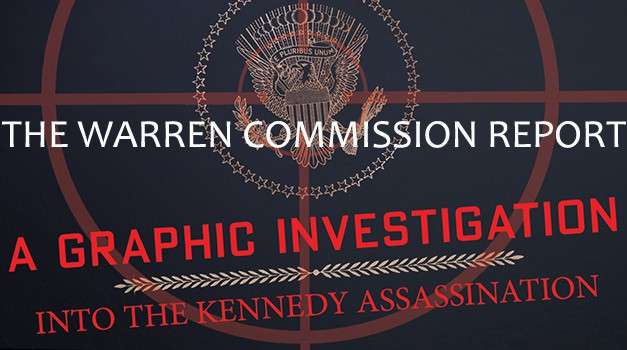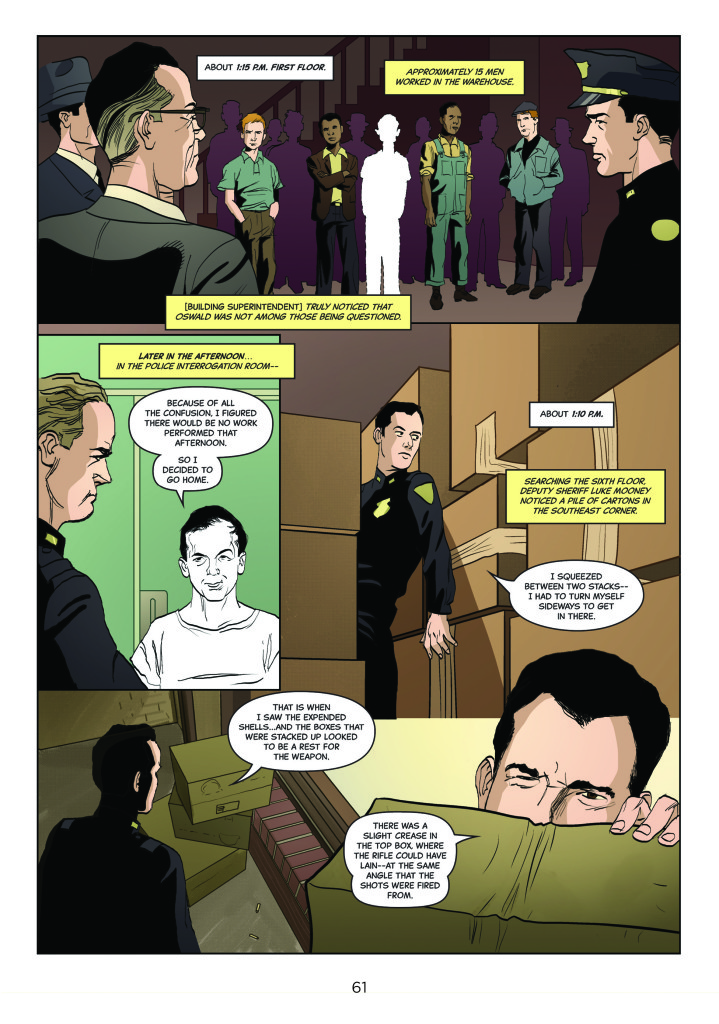The Warren Commission Report: A Graphic Investigation into the Kennedy Assassination by Dan Mishkin
Fifty years ago this week, the President’s Commission on the Assassination of President Kennedy—better known as the Warren Commission—released its official finding: an 889-page report asserting that Lee Harvey Oswald acted alone in assassinating President John F. Kennedy, and that Jack Ruby similarly acted alone in killing Oswald, who was in police custody and being transferred to a county jail at the time of his shooting.
Perhaps the only event in American history as closely scrutinized as Kennedy’s assassination was the report designed to settle all inquiries about the crime. To this day, the debate over whether or not Kennedy died at the hands of a conspiracy involving organized crime, communist agents or our own government still rages, and over the years, the Warren Commission report seems to have raised more questions that it has answered.[giveaway giveaway_id=1679 side=”right”]
It’s the examination of the commission’s findings, in the political and social context of the era, that forms the basis of The Warren Commission Report: a Graphic Investigation into the Kennedy Assassination. Written by Dan Mishkin and illustrated by Ernie Colon and Jerzy Drozd—a trio whose past employers include Marvel, DC, Image, and Harvey Comics—the book utilizes words and images to explore the assassination and the commission report in a way no other medium can.
The book begins by taking the reader through that fateful day in Dallas and its immediate aftermath, in a nation desperate for answers and reeling from a crime that would forever alter its history. Oswald was arrested within hours of Kennedy’s murder. The evidence against Oswald is “not very, very strong,” FBI Director J. Edgar Hoover tells President Lyndon Johnson. A day later, however, after Oswald is killed, Hoover tells Deputy Attorney General Nicholas Katzenbach that what concerns him is “having something issued so that we can convince the public that Oswald is the real assassin.”
The book is careful to neither support nor deny the findings of the Warren Commission. But it is against the backdrop of the government’s attempt to “settle the dust” over the Kennedy assassination that the report’s greatest flaw is revealed: the report, according to the book, presents its findings in such an open-and-shut manner that it cannot help but call attention to the questions that its findings inadvertently raise.
And those questions are legion. How can they not be? As the book shows, the forensics surrounding the case are so vast and complex that they seem overwhelming. For example, countless Dealey Plaza witnesses supplied an endless stream of contradictory testimony. And over time, the stories of individual witnesses change as they are seen through the fog of time and faulty memory.
Were there two shots? Three? Four? Sound reverberates wildly through Dealey Plaza. Where did the shots come from? From above? From the ground? From in front? From behind? A rifle is seen in the window of the Texas Book Depository. A puff of smoke is also seen from a nearby bush, where cigarette butts are later found. Was a smoker watching the presidential motorcade from that location—or did the smoke come from the gun of a second shooter?
These are just some of the many questions raised during the closed testimony before the Warren Commission. And the problem, according to the book, isn’t that the questions weren’t addressed—the problem is that too many of them are answered with such finality. “The report promotes an airtight case, much as conspiracy theorists will later do,” Mishkin writes, “selecting the most favorable evidence, treating its own interpretations as the only plausible ones, and dismissing inconsistencies.
“What the report does reveal is excessive attention to small details, even when those details lack explanatory powers…as if more words mean more proof,” writes Mishkin. “Commission attorney Wesley Liebeler complains that it is written far less as a fair-minded analysis than as a brief for the prosecution of Lee Harvey Oswald.”
So did Oswald act alone in killing Kennedy, and did Ruby act alone in killing Oswald? They very well may have. But by weaving its narrative through the words and imagery of those historic days in 1963, this unique book shows how the Warren Commission report, designed to answer every question about the assassination, has only served to feed the suspicions and fears of those who suspect a conspiracy. The report itself, the book says, has stoked the flames of doubt it was designed to extinguish.
Days after the Warren Commission report was made public, a newsman asked commission member Richard Russell, a Georgia senator who had been critical of the report’s findings, if he was glad that the investigation was over. “Do you really think it’s over?” Russell replied. “They’ll be debating this thing for a hundred years.” The words and illustrations of The Warren Commission Report: a Graphic Investigation into the Kennedy Assassination form a fascinating new chapter in that ongoing debate.
Images provided by and reprinted with permission of Abrams Books
Buy this Book!
Amazon







